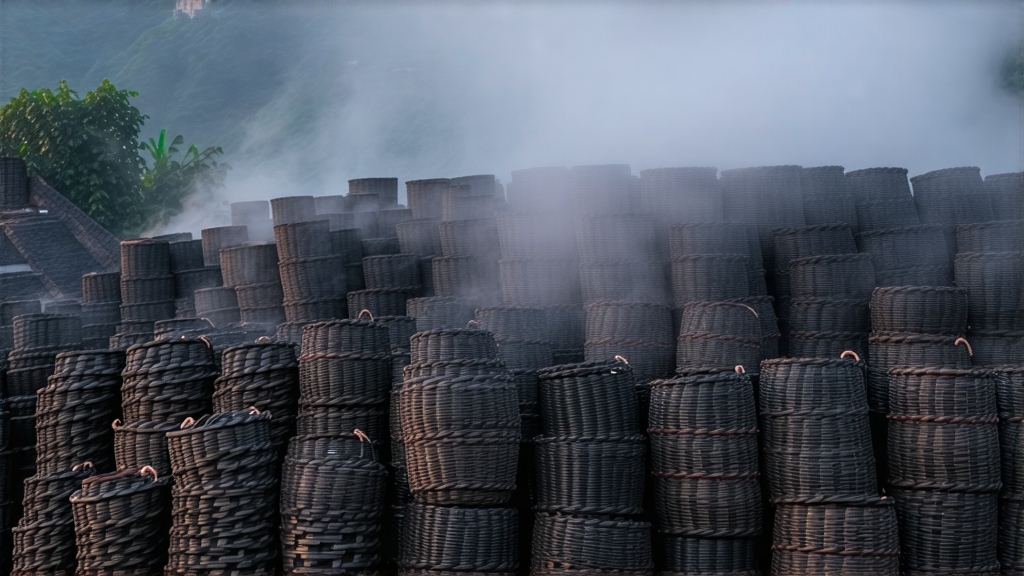
Tucked away in the subtropical mountains of southern China’s Guangxi Zhuang Autonomous Region, Liu Bao tea has quietly fermented for five centuries, yet remains largely unknown outside serious dark-tea circles. To the global drinker who has met only Pu-er, Liu Bao offers a parallel universe of microbial alchemy: a tea that was born on mule caravans, perfected in humid cellars, and prized in Kuala Lumpur coffee shops long before the word “craft” was ever attached to fermentation. This article invites you to travel the winding Wu River with the leaf, to understand why its flavor can recall dark honey, camphor, and the faint sweetness of betel nut, and to learn how to coax those notes from a basket-aged brick in your own kitchen.
-
Historical footprints from frontier to diaspora
Liu Bao takes its name from the old Liu Bao market town in Wuzhou prefecture, once the last riverine stop before goods disappeared into the limestone karsts bordering Vietnam. During the Ming Jiajing era (1522–1566), imperial edicts designated Guangxi as a key corridor for “border tea” exchange; compressed dark leaves were bartered for horses with upland tribes. Muleteers noticed that after weeks of monsoon drenching and body-heat steaming, the originally greenish tea mellowed into a deep amber liquor that calmed stomachs and sold for higher prices. By the Qing Qianlong period, Liu Bao was being loaded onto bamboo rafts, floated down the Xi Jiang tributary, and transshipped through Hong Kong to reach the Nanyang—Southeast Asia’s Chinese diaspora. In the 1950s Kuala Lumpur wet markets, a tin of Liu Bao cost more than a tin of breakfast coffee; Malaysian tin-mine workers drank it to dissolve the grease of coconut rice and to cool the body in equatorial heat. Thus, a frontier currency became a diaspora comfort, aging gracefully in bamboo baskets under stilt houses while Europe remained preoccupied with black Keemun and green gunpowder. -
From leaf to maocha: the killing-green that is not quite green
Unlike Yunnan’s large-leaf Pu-er, Liu Bao begins with medium-leaf Camellia sinensis var. sinensis bushes that cling to granite soils at 300–800 m elevation. The first difference appears in the withering yard: leaves are spread only 3 cm thick so the mountain fog can soften them for two hours—just long enough to lose the grassy edge while retaining a faint astringency. A short 3-minute pan-fire at 160 °C follows; growers call this “killing the horse,” a playful inversion of Pu-er’s “killing the green,” because the goal is to arrest oxidation yet leave a whisper of enzymatic life that will wake up later in the humid pile. Rolling is done on 80-year-old pine tables whose resin pores impart a subtle pinewood perfume. After a 40-minute sun-dry, the maocha is ready, jade-brown ribbons that smell of rain on hot slate. -
The dui-wui: piling where microbes dance
Guangxi’s average annual humidity of 78 % turns the factory floor into a subtropical incubator. Workers build 1.2-meter piles, sprinkling 8 % water by weight, then cover them with jute sacks and rice-straw mats. For the next 25 days the pile breathes: internal temperature climbs to 52 °C, Aspergillus niger and Blastobotrys adeninivorans bloom, and the leaf edges turn oil-black. Every four days the pile is turned, sprayed, and aerated—an operation accompanied by the rhythmic slap of wooden shovels that echo through the brick warehouses like distant drums. When the core finally smells of dried longan and wet mahogany, the fermentation is arrested by a final sun-bask on bamboo trays, reducing moisture to 12 % and locking in the signature “betel-nose” aroma. -
Compression and the second life in baskets
Traditional Liu Bao is never pressed into 357 g Pu-er-style cakes; instead, 50 kg of fermented leaf is steamed for 90 seconds, then tamped by foot into cylindrical bamboo baskets called longzhu that stand waist-high. A cotton liner is sewn shut, and the basket is left inverted so gravity tightens the core. After three months the cylinder is opened, revealing a glossy black column streaked with golden sp